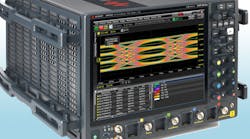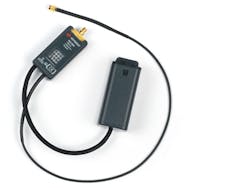1. Shown is the UXR0704A Infiniium UXR-Series oscilloscope, a four-channel model with a bandwidth of 70 GHz.
Furthermore, 3.5-mm input connectors are built into UXR-Series models with bandwidths as high as 33 GHz; instruments with bandwidths between 40 and 70 GHz are built with 1.85-mm connectors. Also available for purchase is a 59-GHz model with 1.0-mm input connectors. Finally, 80-, 100-, and 110-GHz models all come with 1.0-mm connectors.
Getting to Know the Performance
One cannot help but notice the advanced technology built into the UXR-Series instruments. Specifically, a 110-GHz Infiniium UXR-Series oscilloscope with four channels contains over 80 custom application-specific integrated circuits (ASICs) and 13 field-programmable gate arrays (FPGAs). It also consists of nine monolithic microwave integrated circuits (MMICs) and 38 thin films.
A 10-bit analog-to-digital converter (ADC) architecture lies at the heart of the UXR-Series. It allows for a vertical resolution that’s four times greater than what’s attainable with an 8-bit ADC architecture. Employing a 10-bit ADC architecture also results in a better signal-to-noise ratio (SNR) in comparison to utilizing an 8-bit architecture. On top of that, the architecture enables hardware-supported vertical scaling as low as 4 mV/div. With software-assisted magnification, vertical scaling can be as low as 1 mV/div.
UXR-Series models with bandwidths as high as 33 GHz can achieve a maximum sampling rate of 128 Gsamples/s. All other higher-frequency versions reach a maximum sampling rate of 256 Gsamples/s. In addition, the ENOB is 6.8 bits at 13 GHz; 5.4 bits at 70 GHz; and 5.0 bits at 110 GHz.
Low-noise performance is a key aspect of the UXR-Series instruments. For example, a 13-GHz bandwidth model has a noise floor of 150 µVrms with a full scale of 32 mV. A 70-GHz version achieves a noise floor of 500 µVrms with a full scale of 60 mV. For a 110-GHz model, the noise floor is 860 µVrms with a full scale of 60 mV.
In terms of memory, the oscilloscopes offer a standard memory depth per channel of 200 Mpoints. Customers also have the option to upgrade to either 1 or 2 Gpoints.
Other Significant Features
The UXR-Series is upgradable in more ways than one—Keysight offers the option to boost the bandwidth of these instruments. That means that the bandwidth of, say, a 13-GHz model can be upgraded to 110 GHz. In addition, any two-channel oscilloscope can be upgraded to a four-channel version.
Backwards compatibility is another notable feature of the UXR-Series. The instruments run the same software used with older Infiniium S-, V-, and Z-Series oscilloscopes; they support existing Infiniium applications; and they will run with remote command programs that have already been written.
In addition, models with bandwidths ranging from 13 to 33 GHz have the same AutoProbe II interface as Infiniium V- and Z-Series oscilloscopes. That means the same probes used with those older oscilloscopes can still be used with the UXR-Series instruments. For higher-frequency models, the same probes can be employed by applying a simple adapter.
A Keysight proprietary indium-phosphide (InP) integrated-circuit (IC) process is leveraged in the UXR-Series. This process is used in the pre-amplifier, trigger, sampling, and probe amplifier IC designs. The custom InP ICs designed for the UXR-Series enable the instruments to achieve bandwidths as high as 110 GHz without frequency interleaving. This is significant because frequency interleaving is a process that introduces noise and distortions to the measured signal.



